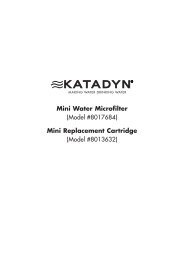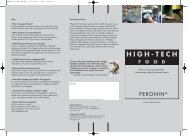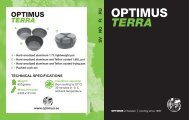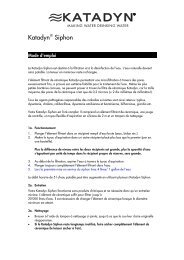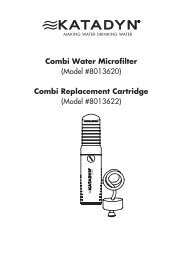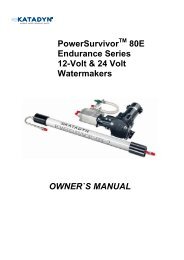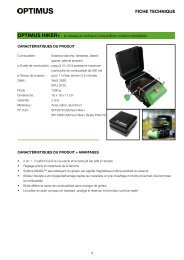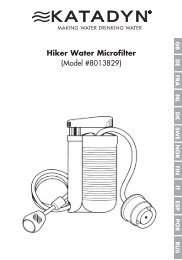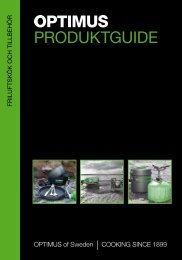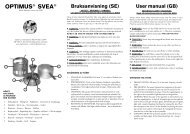Installation Instructions Repair Seal Kit PS 80E
Installation Instructions Repair Seal Kit PS 80E
Installation Instructions Repair Seal Kit PS 80E
You also want an ePaper? Increase the reach of your titles
YUMPU automatically turns print PDFs into web optimized ePapers that Google loves.
INSTALLATION INSTRUCTIONSREPAIR SEAL KITPowerSurvivor <strong>80E</strong>PURPOSE OF THE KITThe <strong>Repair</strong> <strong>Seal</strong> <strong>Kit</strong> should be installed after 1000 hours of operation. It should be installed regardlessof whether or not there is leakage or a reduction of fresh water. Learning to perform this procedure willensure optimal performance of your watermaker.NOTE: If the unit has been operating in water with silt or higher than normal salinity, the <strong>Seal</strong>s willwear somewhat faster.Before beginning the <strong>Repair</strong> <strong>Kit</strong> procedure, note the following precautions:1. Keep the work area clean of dirt, hair, and other contaminants.2. Avoid scratching Pump Components when removing or replacing O-rings.3. Never use petroleum-based lubricants on <strong>Seal</strong>s and O-rings as a substitute for SiliconeGrease.4. When installing O-rings do not roll or twist them.NOTE: Average time to replace all seals is 1 hour. If you are performing this maintenance for the firsttime, expect 3 hours.KIT CONTENTS (See Figs. A-3 and A-4)TOOLS REQUIREDPiston <strong>Seal</strong> <strong>Installation</strong> Tool – supplied with kitNeedle-nosed pliers¼-inch Allen wrench½-inch open-end wrench11/16-inch open-end wrench7/8-inch open-end wrench½-inch deep socket and socket wrenchsmall flat-blade screwdriversmall scissorsPrint No.: 8012825/0 Katadyn North A merica Inc. Katadyn P roducts Inc.4830 Azelia Avenue North Pfäffikerstrasse 37Minneapolis, MN 554429 U.S.A.8310 Kemptthal SwitzerlandTel +1 800 755 6701 Fax +1 763 746 3540 Tel +41 44 839 21 11 Fax +41 44 830 21 99marine@katadyn.com www.katadyn.us info@katadyn.ch www.katadyn.ch
Disassembly:1. Before beginning disassembly, run the watermaker and stop it when the piston shaft is at itsfarthest point of travel away from the pump (toward the drive assembly). This provides enoughroom for sliding the rubber bootback toward the pump in Step 3.2. Use the 11/16" open-end wrenchto disconnect the two highpressurehoses (coming from themembrane housing) from the tubeconnectors on the check valveplate and the valve assembly.Loosen the hose clamps andremove the reinforced plasticseawater intake and reject brinehoses. See Figure R-1.3. Use the 1/2" open-end wrench toremove the four hex nuts securingthe pump back plate to the driveassembly. Then pull the pumpaway from the drive assembly to expose as much of the piston shaft as possible. Slide the blackrubber boot on the piston shaft toward the pump to expose the shaft coupling pin. Use a smallscrewdriver or allen wrench to push the coupling pin out of the shaft. (Note: the coupling pin is aloose fit and may fall out on its own.Do not lose it.) Separate the pumpfrom the drive assembly and set thedrive assembly aside in a safe place.Slide the black rubber boot off thepiston shaft. Move the pump to aclean work surface for furtherdisassembly. See Figure R-2.4. Remove the plastic intake hose barbfrom the check valve plate. Whilethe pump is still bolted together, usethe 7/8" open-end wrench to justloosen the tube fitting in the checkvalve plate. Then use the 1/4" allenwrench to remove the six socketheadflange bolts that hold the check valveplate to the pump body. Separatethe check valve plate from the pumpbody and remove the large o-ring(8012830) seal between them. See Figure R-2.
5. Disassemble the two check valve assemblies. Use the needlenose pliers to lift the intake valveretainer, valve spring and poppet valve out of their bore in the inside surface of the check valveplate. Remove the tube fitting, reject check valve retainer, valve spring and poppet valve from theirbore in the outside surface of the check valve plate. To remove the valve seats, use an allen wrench(or similar flat-ended tool) to push each valve seat out of its bore, working from the opposite sideof the bore from which the rest of the valve assembly was removed. See Figure R-3.6. Separate the pump back plate from the pump body by first using the 1/4" allen wrench to re-movethe four sockethead flange bolts that hold them together. It is unlikely that the two parts willseparate easily. Insert the wide end of the piston seal installation tool into the pump body cylinderfrom the check valve side of the pump body until it contacts the exposed end of the piston. Use asoft mallet to tap the small end of the installation tool and drive the piston and pump back plateaway from the pump body. When the back plate has separated from the pump body, pull thepiston out of the back body and remove the two old o-rings (8012830) and (8012444). Be carefulnot to lose the large relief valve spring that is exposed when the pump parts separate.7. Remove the old PIP ring and cup seal from the piston. One method to accomplish this is to wedgea small screwdriver underneath thecup seal and pry it up far enoughthat it can be cut with a pair of smallscissors or a razor blade. Repeat theprocess for the PIP ring.8. Remove the wiper block from thepump back plate, and use a pair ofneedle-nose pliers to pull the oldwiper block seal out of the wiperblock. Remove the spacer washer, ifpresent. Working from the side ofthe back plate that faces the pumpbody, use a flat-ended tool or asmall socket on an extension to press out the two backup washers, two piston shaft seals and shaftbushing from the back plate. Refer to Figure R-4. This completes the disassembly of all userserviceableparts of the Katadyn PowerSurvivor <strong>80E</strong> watermaker.
Reassembly: Before you begin reassembly of the watermaker, clean all parts using clean, lint-freerags. At this time, all parts should be carefully inspected for wear or damage. Use a 10x magnifier orloupe to examine the seals, o-rings and other small parts. Stubborn rust stains and deposits on metalparts may be cleaned with a soft-metal wirebrush (e.g., stainless steel or brass). Do not use polishes,cleaning compounds containing abrasive materials, or regular steel wire brushes. Refer to the explodeddrawing of the pump in Figure A-2 in the Appendix for the location of parts and seals duringreassembly. Refer to Figures A-3 and A-4 in the Appendix for full-size drawings and identification ofthe components included in the <strong>Repair</strong> <strong>Seal</strong> <strong>Kit</strong>. In the following procedure, references to the <strong>Repair</strong><strong>Seal</strong> <strong>Kit</strong> will be abbreviated to “RSK.” It will be assumed that all o-rings, seals, and mating surfaceshave been lightly lubricated with non-petroleum silicon grease (supplied with the RSK).Warning: Use only non-petroleum silicon grease to lubricate your watermaker. Lubricants with apetroleum base will damage several watermaker components, including the reverse osmosis membrane.Be especially cautious of lubricants that “contain” teflon, silicon, etc.—such products couldalso contain petroleum-based components. An ample supply of silicon grease is included with eachRSK. Reinstall the piston: If you want to replace the O-rings on the piston, refer to the figure below• Install washer with chamfer onwasher facing ½” dia of plungerrod and a new O-ring onto theplunger rod, if you have an oldstylepiston, you only have toinstall a new O-ring into theplunger rod without a washer.• Slide piston onto the threadedend of the plunger rod, andsecure with the washer and nut.1. Refer to Figure R-5 during the following procedure.Place the piston assembly on a flat, stable surfacewith the shaft pointing up. Slide the installation tool(provided in the RSK) over the piston shaft with thewide end down. Lubricate the new PIP ring, cupseal and the installation tool with silicon grease.With the grooved side facingup, slide the PIP ring down theinstallation tool and onto thepiston. Repeat this process forthe cup seal. Note that thegrooved side of the cup sealshould be facing down; i.e.,the grooved sides of the PIPring and the cup seal shouldbe facing each other. Whenfinished with the installation,remove the installation toolfrom the piston shaft.2. To install the check valve components, refer to Figure R-3. Locate the two new check valve seats inthe RSK. Observe that the hole in the center of each valve seat has a beveled edge on one side.Use your finger to press a valve seat into the bore for the reject check valve assembly. The seatshould be pressed all the way in, with the beveled side of the valve facing outward (that is, against
the end of your finger). Use the same technique to install the other valve seat in the bore for theintake check valve assembly. It too should be installed with the beveled edge of the valve seatfacing outward, or against your finger.3. With its cross side facing down (facing the valve seat), lower a new poppet valve into the bore forthe reject check valve. The poppet valve should be level and in the center of the valve seat at thebottom of the bore. Observe that one end of the valve retainers has a shallow hole that is the samediameter as the valve spring. Press a new spring into the hole in one of the retainers. Wheninstalled correctly, the spring should stay in the valve retainer when it is inverted. Lower the springand valve retainer into the reject check valve bore with the spring facing the poppet valve. Makesure the tube fitting still has an o-ring installed and then screw it into the reject check valve holeand tighten securely with the 7/8" open-end wrench. Test your installation by inserting a smallscrewdriver into the hole for the reject check valve onthe side of the check valve plate opposite the tubefitting. The reject poppet valve should move up anddown slightly.4. Screw the plastic intake hose barb into the checkvalve plate (See Figure R-2). Then, working from theother side of the check valve plate, install a newpoppet valve, valve spring and valve retainer, usingthe same procedure as was used for the reject checkvalve assembly. Lubricate a new o-ring (8012830)with silicon grease and install it into its groove in thepump side of the check valve plate.5. Taking care that the intake check valve componentsdo not fall out of their bore, bring the check valve plate and the pump body together, align them,and install the six sockethead flange bolts to hold the assembly together. Tighten these fastenerssnugly. (If a torque wrench is available, tighten to approximately 120–140 in.-lbs.) Use a pencileraser or small screwdriver to test the action of the intake poppet valve. See Figure R-6.6. Lubricate the inside of the cylinder in the pump body with silicon grease. Insert the piston assemblythrough its hole in the pump back plate andslide it as far as it will go toward the pumpback plate, as shown in Figure R-7. Installthe two o-rings (8012830) and (8012444) intheir grooves in the pump back plate. Makesure the relief valve spring is installed in thepump body. Bring the pump back plate andpump body together carefully, first guidingthe piston into the cylinder in the pump body,and then pressing the back plate as close aspossible to the pump body. Install the foursockethead flange bolts and tighten snugly(approximately 120–140 in.-lbs.)
7. Refer to Figure R-8. Slide one backup washer over the piston shaft and down into the shaft bore inthe pump back plate. Slide one of the shaft seals over the end of the piston shaft with its flared side(the side with an embedded o-ring) facing the pump back plate. Slide it down the shaft and gentlywork it into the shaft bore.In-stall the second shaft sealin exactly the same way,with its flared side alsofacing the pump back plate.Work it into the shaft boreand press both seals in untilthe back of the second sealis about flush with the top ofthe shaft bore. Next, slideon the second backupwasher, followed by thewhite plastic piston shaftbushing. Finally, slide thepiston installation tool onto the piston shaft, small end first, and use it to push the backup washers,piston shaft seals and bushing all the way into the shaft bore, until the outside face of the bushingis flush with the top of the shaft bore. Remove the piston installation tool. If it was present when youdisassembled the pump, install the thin plastic spacer washer.8. Press a new wiper block seal into the groove in the center of the wiper block. Squeeze the seal intoan oval and start one edge into the groove. Then work the rest of the seal in until it seats evenlyinside the wiper block bore. Slide the wiper block onto the piston shaft and press it down into thecavity in the pump back plate. The side of the wiper block from which the seal was installed shouldface outward. Slide the black rubber boot onto the piston shaft. Its flat side should face the pump.9. Place the assembled pump next to the drive unit and check the alignment of the coupling pin holein the end of the piston shaft. Insert an allen wrench or small screwdriver through the coupling pinhole and use it to rotate the shaft until it will align with the hole in the slider shaft of the driveassembly. Bring the drive assembly and pump together carefully and, when the holes in the pistonshaft and the slider shaft are aligned, press the coupling pin through the holes and slide the rubberboot over the coupling pin to hold it in place. Install the four hex nuts on the studs projectingthrough the flange on the drive unit and tighten them securely.10. Refer to Figure R-1 and install the two high pressure hoses, the seawater intake hose and the rejectbrine hoses to the pump assembly. Tighten the hoses clamps on the two reinforced plastic hoses.This completes the procedure for reassembly of the watermaker. When operation is commencedagain, carefully check for any leaks or other signs of incorrect assembly.




